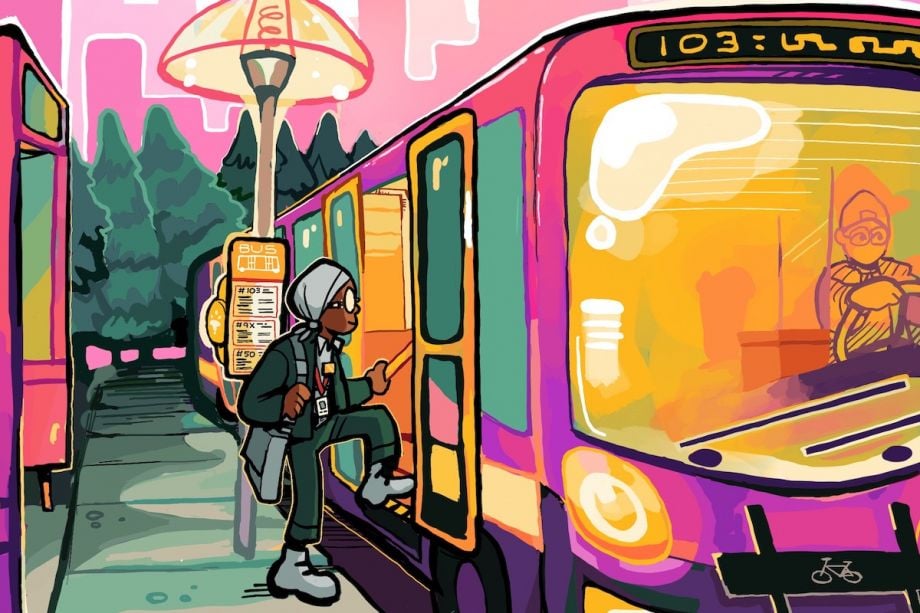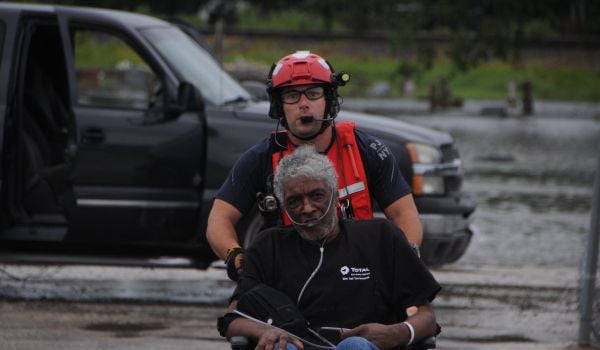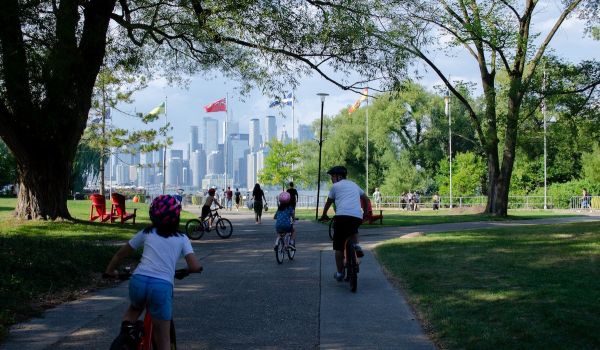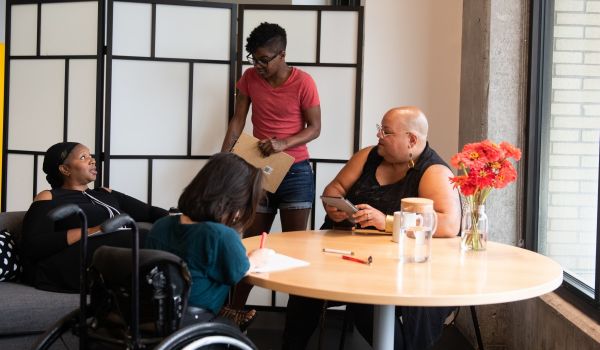Next City and Prism’s series “Disability Justice For All,” covers how people of color are leading a disability justice movement in American cities, making strides toward equity in housing, mobility, labor, health care and beyond.
Tanisha Sepulveda was at a community center in Tukwila, Washington when she noticed that the center lacked a few basic features for accessibility.
It wasn’t just the building, but the infrastructure around it. “The nearest bus drops you off 20 minutes walking distance from there, and there’s almost no sidewalks to get there,” says Supulveda, a wheelchair user and disability justice advocate. She lives in Seattle, just 15 minutes away by car. But for those who don’t or can’t drive, that can be an impossible distance.
“How can this be a community center when it’s literally only serving a neighborhood and people who can drive?” she asks.
While the building itself may have been ADA compliant, the ADA is the “bare minimum when it comes to the actual needs of people with disabilities,” says Sepulveda. “How does one evaluate the ADA of a building [when] it’s so much more than just the building itself?”
Four years ago, the nonprofit Disability Rights Washington (DRW) launched the Disability Mobility Initiative to spread awareness of systemic issues non-drivers face when trying to fully participate in their communities. The following year, the initiative started the statewide “Week without Driving” challenge to help council members and community members alike understand the challenges that non-drivers face when trying to access their communities through alternative transportation. Participants can get around however they choose, but they must not drive themselves in any car. This rule also applies when participants typically transport other family members and friends.
Inevitably, some participants break the commitment and drive because they can’t find an alternative. Rather than seeing this as a “failure,” those who reach this point should consider how someone without the option to drive would’ve coped. Would they miss an important work meeting or doctor’s appointment? Would they be unable to transport all their groceries home or complete other essential tasks?
While the challenge brings awareness to the struggles non-drivers face more broadly, it doesn’t capture inequities between transit routes in various geographical regions.
If someone in a neighboring rural area, for instance, wanted to work in Seattle, “it could take them an hour and a half, two hours-plus to even get here” using public transportation, says Sepulveda, program coordinator for Empower Movement WA, DRW’s BIPOC-led advocacy group.
Since its inception, the initiative has been compiling stories from non-drivers throughout the state and documenting them in the Transportation Access for Everyone StoryMap. It includes interviews with more than 270 non-drivers about the barriers they face when navigating their communities. By analyzing common threads in these stories, DMI was able to put together a research paper that makes targeted recommendations for stakeholders to improve public transportation infrastructure.
America’s disabled non-drivers
According to the Bureau of Transportation Statistics, 13.4 million Americans between the ages of 18 and 64 have self-reported travel-limiting disabilities. Only 1 in five of people within this group work full time or part time, while 3 out of 4 Americans without disabilities aged 18-64 work.
As of 2017, and compared to previous years, disabled people made fewer daily trips and were less likely to work. The COVID-19 pandemic has worsened these barriers, which remain even after the U.S. government no longer deemed the virus a public health emergency despite the increased and continued risks for immunocompromised people.
COVID-19 has also created new disabilities as “untold numbers of people” experience “a variety of long COVID symptoms … that have affected things like their ability to work [and] their stamina to do things like walk,” says Valerie Novack, disability policy researcher. Also worth noting is that “we are in a period where we have a significant number of people reaching a very senior age,” she says.
From 2010 to 2020, the older population saw its largest percentage point increase in U.S. history. Between 2010 and 2020, the 65-plus population grew from 13% to 16.8%. Before 2010, it took five decades for the older population to grow by the same number of percentage points.
“People with disabilities are the only minority that is growing every day,” Sepulveda, who became paralyzed at 20, says. “Anyone can join at any time, you never know. And the fact that we have an aging population makes that inevitable.”
The aging population is more likely to have disabilities that impact their ability to travel. There are more than 11 million people with travel-limiting disabilities aged 65 or older in the U.S. This group accounts for almost 44% of people with disabilities, and they account for less than 24% of their age group.
Pregnant women, both with and without disabilities, who rely on public transportation face challenges in accessing health care, which can lead to an increased risk of developmental disabilities for children as well as maternal mortality.
Black women are more likely to rely on public transportation as well, with one study on Black women in the Boston area revealing that 50% of participants have been late or missed medical appointments due to public transit.
Disabled parents find that it can be challenging to receive accommodations for both themselves and their kids. Sarahbeth, who lives in Bellingham, used to use fixed-route transit but started to use paratransit after her mobility decreased. The provider would only allow her to bring one of her children with her. She also found that she was not able to properly secure her child’s car seat.
“The bus administration insisted they only had to accommodate me but not my child. I feel this is a sexist [loop]hole in law and policy, and it purposely keeps disabled parents from transporting their children,” she explained in the DMI report.
Transit access and employment for people with disabilities
Disabled people face barriers at the intersection of income inequities, employment access, and transportation.
Transportation is the second biggest expense for low-to-moderate household budgets (LMI), second only to housing costs, according to 2022 survey data from SaverLife. Moreover, 45% of LMI respondents said they decided not to apply for or accept a job because the transportation costs were too high.
People with disabilities are less likely to own vehicles and less likely to drive than their able-bodied counterparts. They are 77% more likely to say their life opportunities are limited by transportation expenses than those without disabilities.
People with travel-limiting disabilities tend to have lower incomes, with more than half of all people aged 18-64 with disabilities living in households with incomes under $25,000, compared to 15% of non-disabled people from the same age group.
Public transit can be more unreliable and time-consuming than driving, and those with disabilities have to account for this when trying to hold a job, as we can see reflected in accounts recorded in the StoryMap.
Merribeth, who has low vision, arrives early to work every day because she leaves extra time on her commute in case a bus is late. She isn’t allowed to clock in until her shift begins. While driving to her workplace would only take 10 minutes, her commute by bus can take 45 minutes. Some days, she even shows up 45 minutes early, eating unpaid hours of her day to get to work on time.
Harry from Vancouver has a seizure disorder and went from driving to depending on public transit. Because of transit schedules, he had to go from working full time to part time.
Additionally, his seizures are more likely to occur if he is in extreme heat. “Every day during extreme weather I spend the entire day in more fear knowing that the chances of my having a seizure have increased tenfold,” he explains. Public transportation can also be shut down during extreme weather.
“Usually there are fewer buses available,” he says. “That puts a huge amount of pressure on those of us who rely on it for simple tasks, let alone major tasks such as going to the doctor or getting to work.”
The switch to green infrastructure must account for accessibility
The push for green infrastructure in Washington can further enforce these barriers of location, travel costs, and accessible infrastructure.
Transportation emissions make up almost 45% of Washington’s greenhouse gas emissions. Gas-powered vehicles are the culprit for more than half of the state’s transportation emissions.
At the end of 2022, the Washington State Department of Ecology updated its Clean Vehicles Program to include a sales mandate to incrementally increase the sales of zero-emissions vehicles. By 2035, zero-emissions vehicles (electric cars and hybrids) will make up 100% of new sales.
While this can greatly reduce emissions, it comes at a cost of vehicle access for folks with disabilities. Electric vehicles tend to be more costly than their gas-powered counterparts. Those with mobility disabilities involving a wheelchair must also face additional costs to add accessible upgrades like ramps.
Moreover, investments into the shift toward electric vehicles don’t “necessarily take into account the infrastructure like sidewalks and roads that electric vehicles would be on,” says Sepulveda.
Charging stations for electric vehicles “aren’t always the most accessible,” in comparison to their gas station counterparts, she notes. For those who cannot physically bear the weight of a gas pump, “there tends to be gas attendants or people around in a gas station, but … the electric vehicle charging stations never have anyone around unless there happens to be a car user or pedestrian that might be able to help you,” she says. “It’s a crapshoot.”
The switch to EVs does show hope for improving funding opportunities for accessible transportation as it poses the potential for reshaping the 18th Amendment of the Washington State Constitutions, passed in the 1940s, that limited the state’s main transportation funding source, the gas tax, to highway projects.
Now that the state is transitioning away from gas-powered vehicles and the state must find alternatives to the gas tax, this is a chance for new revenue sources to fund a more robust transportation infrastructure, the research paper based on the Transportation Access StoryMap suggests as a next step.
Building an accessible transit system
How do we change public transportation to actually meet the needs of disabled non-drivers? The transportation access research paper ends with a series of recommendations for elected leaders, agency staff, transit providers, and transportation departments.
Participants from the StoryMap often expressed that their mobility needs are afterthoughts when it comes to transportation access and that they are left out of the decision-making processes that determine the state of transportation in their regions.
Standalone accessibility committees are an insufficient resource to implement changes to make the system fully accessible, the research paper states, noting that advisory committees at a minimum should compensate participants.
Moreover, transit agencies should stop listing requirements such as drivers licenses and the ability to lift 50 pounds when they are not essential to the job role. These requirements directly exclude non-drivers and people with disabilities from serving in roles where their input will be heard.
The report also suggests that more data should be collected on the experiences of non-drivers with disabilities. How often do those with service animals get denied by ride-sharing and taxi drivers? How often do wheelchair users get denied boarding because ADA-accessible seating for mobility aids is at capacity?
Transportation agencies should ensure transit connects riders to key destinations where medical services, education, and recreation are offered. They should coordinate between jurisdictions to reduce transfer wait times and develop and improve tools to help riders anticipate the arrival of their busing system and increase overall consistency.
Accessibility advisory committees alone do not empower those with disabilities to actually have a seat at the table. They are also often unpaid, which demonstrates a cultural devaluing of people with disabilities. “To be clear, we don’t need new processes or new accessibility committees that risk sidelining us,” the report reads. “Our voices must be welcomed into rooms and conversations where these decisions are already happening.”

Bianca Gonzalez (she/they) is a writer intent on using words as a tool for social change. She is a solutions journalist for Next City, a case study writer for Community Solutions, and a daily news writer for Biometric Update. As a queer, Latina brain cancer survivor, she believes that justice is fundamentally intersectional.

















Add to the Discussion
Next City sustaining members can comment on our stories. Keep the discussion going! Join our community of engaged members by donating today.
Already a sustaining member? Login here.